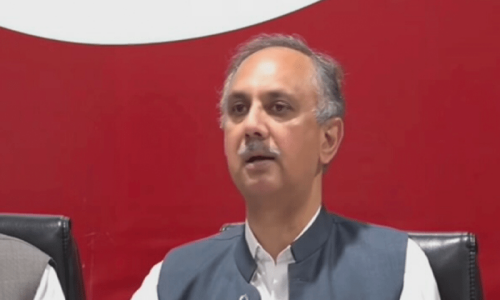KARACHI: “During Eidul Azha this year, we collected 7.3 million hides and skins. Of them, 2,500,000 were cow and buffalo hides, 4,000,000 goat skins, 800,000 sheep skins and 30,000 camel hides. But otherwise it is far less than that. For instance, usually we get between 60,000 and 70,000 hides in a month,” says Aamir Majeed, vice chairman of the Pakistan Tanners Association.
The leather tanneries in Karachi’s Korangi Industrial Area have only just reopened after the Eid holidays. “It’s a process of some seven days turning the hides and skins into the wet blue material which cannot be stopped once started. So we close the tanneries for several days ahead of the holidays. If we stop the process midway, the hides and skins will rot. They can only be preserved at the wet blue stage and from there turning wet blue into leather takes 10 to 13 days,” Mr Majeed says.
 |
| Workers sit on the floor with butcher knives to cut open the hides and skins. Photos by Fahim Siddiqi / White Star |
The process as explained by him begins with salting the hides and skins. “If the hides or skins are left just like that, they become completely useless for us after 10 hours. Actually, with the passing of each hour, their value starts going down. So there are several things, which you can do to save them, including keeping them in shade, turning them over and preserving them in salt. You need around three to four kilograms of salt for cow and buffalo hides and half a kilogram for a goat or sheep skin. It’s not too much to ask when you see how you are contributing to the industry with a turnover of 18 billion rupees,” he says.
“Salt is needed for drying the hides and skins as initially they comprise 70 per cent moisture. Once you dry the skin with salt, you stop the bacteria action and hence preserve it,” he adds. This is to be done in a shady place with plenty of airflow.
 |
| Drum liming to remove interfibrillary and keratin proteins, collagen, natural grease and fats. Photos by Fahim Siddiqi / White Star |
According to the Pakistan Tanners Association vice chairman, cattle hides sell for Rs4,000 or Rs4,500 each and goat skin between Rs400 and Rs450, but a camel hide won’t fetch more than Rs800 or Rs1,000. “Well, the leather from the other animals is exported but camel leather due to its poor quality is consumed within the country only. Most of it goes to Multan for making khussa or Saleem Shahi footwear,” he says.
Once collected and brought to the tanneries, the hides and skins that are like a round sleeve have to be cut open. It is a messy stage where workers sit on the floor with butcher knives doing the needful to the stinking, salt covered hides and skins. This is known as ‘charai’ in local lingo. The floor is wet and stained with animal blood.
 |
| Squeezing out water from the wet blue pieces. Photos by Fahim Siddiqi / White Star |
Later, to make up for the lost 70pc moisture, the dried and open hides and skins need to be replenished with clean water to make them supple again. This is done by soaking them in the water that can sometimes be mixed with detergent for cleansing for 12 to 14 hours.
This is followed by liming, which can be of two types — paste liming or paddle/drum liming — which take around 36 to 46 hours. Liming is a mechanical action in big rotating drums carried out to remove interfibrillary and keratin proteins, collagen, natural grease and fats from them.
After that comes the pickling process that prepares the hides and skins for tanning and re-tanning, then more washing until it reaches the wet blue stage.
Mohammad Younus, a tanner, says they have machines to shave the leather to different thickness. “This is done according to order requirements. Some want 0.6mm, some 0.8mm, 0.9mm, 0.10mm or 10.1mm also,” he shares.
“As for size of the skin, Pakistan is known all over the world for having the biggest goats, especially around Eid time as people here select the largest goats for sacrifice here,” he says.
“Pakistan’s leather, anyway, has a very good reputation internationally and due to this our biggest industry and exports after textile is of leather,” he says. “But sadly, the leather industry in Karachi is suffering due to the security situation here. Punjab despite having electricity problems is doing better. But now India and Bangladesh have overtaken us as there is no security problem in those countries where the foreign clients have no trouble moving about.”
Published in Dawn, October 12th, 2014













































